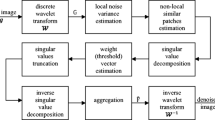Abstract
For traditional thresholding denoising, the wavelet coefficients are thresholded without considering the information of other coefficients. In this paper, we propose a novel denoising approach which incorporates the neighboring coefficients into signal denoising. Our approach not only preserves the coefficients above the threshold, but it also preserves the coefficients predominated by useful components although their magnitudes are smaller than or equal to the threshold. Experimental results illustrate that the proposed approach is better than the NeighShrink scheme and the hard thresholding in both of the visual perception and the numerical results.
Similar content being viewed by others
References
T.T. Cai, B.W. Silverman, Incorporating information on neighborhood coefficients into wavelet estimation. Sankhya, Ser. B 63, 127–148 (2001)
G.Y. Chen, T.D. Bui, A. Krzyzak, Image denoising with neighbour dependency and customized wavelet and threshold. Pattern Recognit. 38, 115–124 (2005)
M.S. Crouse, R.D. Nowak, R.G. Baraniuk, Wavelet-based signal processing using hidden Markov models. IEEE Trans. Signal Process. 46, 886–902 (1998)
D.L. Dohono, De-noising by soft-thresholding. IEEE Trans. Inf. Theory 41, (3), 613–627 (1995)
D.L. Dohono, I.M. Johnstone, Adapting to unknown smoothness via wavelet shrinkage. J. Am. Stat. Assoc. 90, 1200–1224 (1995)
B. Droge, Minimax regret comparison of hard and soft thresholding for estimating a bounded normal mean. Stat. Probab. Lett. 76, 83–92 (2006)
L. Sendur, I.W. Selesnick, Bivariate shrinkage functions for wavelet-based denoising exploiting interscale dependency. IEEE Trans. Signal Process. 50, (11), 2744–2756 (2002)
W. Shengqian, Z. Yuanhua, Z. Daowen, Adaptive shrinkage de-noising using neighborhood characteristic. Electron. Lett. 38, (17), 502–503 (2002)
R.G. Yang, M.W. Ren, Wavelet denoising using principal component analysis. Expert Syst. Appl. 38, 1073–1076 (2011)
Y. Yang, Y. Wei, Random interpolation average for signal denoising. Signal Process. 4, (6), 708–719 (2010)
S.F. Yin, L.C. Cao, Y.S. Ling, G.F. Jin, Image denoising with anisotropic bivariate shrinkage. Signal Process. 91, 2078–2090 (2011)
Author information
Authors and Affiliations
Corresponding author
Rights and permissions
About this article
Cite this article
Yang, Y., Wei, Y. Neighboring Coefficients Preservation for Signal Denoising. Circuits Syst Signal Process 31, 827–832 (2012). https://doi.org/10.1007/s00034-011-9346-1
Received:
Revised:
Published:
Issue Date:
DOI: https://doi.org/10.1007/s00034-011-9346-1




